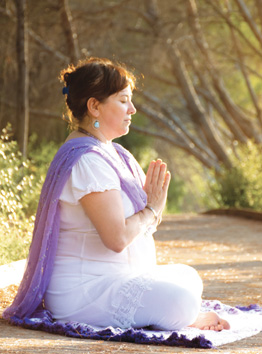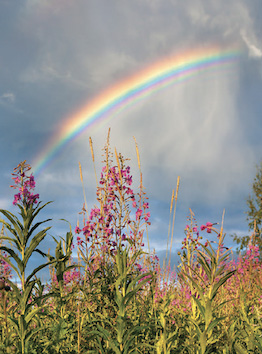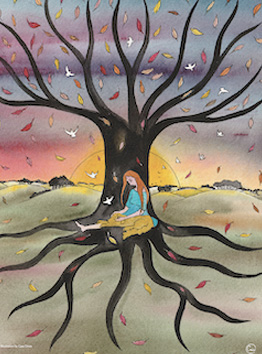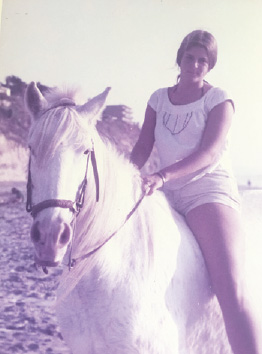
Reiki and Knitting
by Colleen Benelli
First Published – Reiki News Magazine, Winter 2005.
Some may wonder how Reiki and knitting go together, but actually they have a lot in common. We know that Reiki is enhanced by meditation and that a meditative state is often accomplished through a repetitive act, such as focusing on your breath, walking a labyrinth, or using a rosary. Knitting can have a similar effect. When one is knitting, the hands and fingers and the click of the needles develop a rhythm all their own. This automatic process, which is guided by the subconscious, can lead the conscious mind into a state of peace and inward reflection. The mind also becomes open to suggestion and is more easily able to tap into the creative processes that reside within the deeper levels of the mind. Knitting is becoming more and more popular, and many people knit as much for the garments they produce as for the enjoyably relaxing effect it has on the way they feel. According to Linda T. Skolnik and Janice MacDaniels in The Knitting Way: A Guide to Spiritual Self Discovery, “Knitting is an activity rich in spiritual possibility; it is not only a doorway to spiritual community, but also a means for knowing our souls. As a meditative practice, it can center and unburden the self, open- ing us to the divine.”
Because of this, some have combined knitting with other meditative practices including Reiki. Reiki goes well with knit- ting because, as one is knitting, it’s possible to think of Reiki and place Reiki energy into the garment. It’s also possible to place a particular intention or affirmation into the garment as well. Many have created special tools to use in their Reiki practices, such as a Reiki prayer shawl that can be placed on the client, or a Reiki sweater that can be worn while one is giving a treatment. Garments can also be knit that can be given to others contain- ing special healing intentions to help heal a specific condition.
The History of Knitting
The origin of knitting is still a mystery. Some historians date it from the BC era, and others say it began as recently as the sev- enteenth century. For me, the mystery is answered in the meditation of knitting. I can feel the grandmothers and grandfathers who knit before me in my hands. There is a connection of oneness, a cellular memory. Perhaps I can still hear the rhythm of their needles coming forward in time on a bridge of light, on the Long Distance Reiki symbol, through many dates in history.
Skolnik and MacDaniels concur with this experience: “Knitting is like a river that flows between people in such a way that anyone who knits, whether alone or in community, becomes connected to all who have gone before. Knitting links us to the past, to those who knitted for their existence, who knitted for survival, who knitted for beauty and love.”
The earliest known history of knitting comes from discoveries in Egypt. Between the third and sixth centuries knitted socks were buried in Egyptian tombs. In Neolithic times people knit with a single needle, which is a form of knitting called Nålbinding. The earliest example of true knitting using two knitting needles as we use today, comes from Islamic Egypt, where a pair of knitted socks have been dated between 1200–1500AD.
In medieval Europe, knitted garments were all the fashion; the nobility and the wealthy wore silk gloves and stockings and knitted sweaters. Because of this, hand knitting became an important industry. There were professional knitting guilds employing only men that controlled the market. Knitting only became a household activity for women when knitted stockings became so popular.
When it became fashionable for ladies to knit, new stitches, patterns and styles of garments were created all over Europe. Ladies knit delicate lace patterns in France. Knitting in the round with five needles, to make stockings, was developed in Germany. Knitting continued and also became popular in the British Isles, including Ireland, where many styles of hand knitting with intri- cate patterns and textures were designed for fisherman’s sweaters.
Today, we have returned to our love for knitting. We use many of the same patterns and stitches used by our ancestors. And through all of knitted history I can hear the prayers of the people as they knit; some for survival and some for pleasure. Prayers knit for their loved ones just as we knit with prayer for ours. I can hear the click of the needles clicking in the same rhythm of the heartbeat that my grandmothers heard. Praying for life, for the earth, and the people.
Reiki-Guided Knitting
Reiki guided me to knit with its healing power, intention, and prayer. I believe it is an emerging gift that blends healing, touch, creativity, color, meditation, and rhythm through our heart into our hands, into manifested form. Reiki wants to be used in this way. It is teaching us to use it, as it always does.
As I sit here in this moment, I realize how long Reiki and knitting have been my path. I feel as if I was born knowing how to knit, that handwork came with me into this life. And that adding Reiki to knitting and teaching about it was a natural progression that came welling up from within.
My first memory of being guided to knit with Reiki was in 2004 after William Rand had a heart attack. I decided I would knit him a pair of slippers to wear during his recovery. I was on the plane returning from a Reiki class in Sedona, when I found myself knitting and chanting the Reiki symbols into his slippers. Reiki guided my hands and heart, blessed the yarn, created the slippers, and filled them with healing energy and vitality. I witnessed myself doing this, rather than planning it. I remember how my hands felt and how excited I was to have been shown this gift. William later told me he felt Reiki in the slippers, and he said they were wonderful to wear.
Several months later, while I was receiving a Reiki treatment, the practitioner told me she had received very random but specif- ic instructions for me. I was to knit a yellow scarf. Karla was not aware of my history as a knitter; she did not know me this way, so it seemed to be strange information. I told her of my story, and we were both in awe of how Reiki teaches us. Of course I did knit the yellow scarf, imbued it with Reiki, and have been knitting scarves and other things with Reiki ever since. I have been guided to many projects and people and reasons to knit with Reiki.
“Consider a grandmother knitting a sweater for a grandchild just coming into the world. Into the stitches of that sweater go all the grandmother’s prayers for a safe delivery, all of her good feelings about the child and its parents. The work itself is a prayer for the safety and well-being of mother and child, a labor of love, a ritual welcoming of new life inside the extend- ed family or tribe.” —From Knitting Sutra, by Susan Gordon Lydon
Knitting Journey
Last year my husband and I traveled with a friend on a shamanic journey through Nepal and Tibet. I decided to knit a scarf imbued with Reiki and the memories of the “Friendship Highway.” The Friendship Highway is the road from Lhasa, Tibet, to the border of Nepal. It took four days. I connected to Reiki, and while chanting the Long Distance symbol and other symbols, I knit the memories of the smells, the colors, the expe- riences, and the people I met into my scarf.
We traveled through the Himalayas, visited monasteries, and stood on the highest mountain roads at the top of the world. I knit as we drove, chanting the symbols, filling my scarf with the incredible beauty and peace that is Tibet.
In Lhasa, we walked through the Potala Palace, the monastery and ancient home of centuries of Tibetan Dalai Lamas. I was chanting Reiki in the meditation room used by the fourteenth Dalai Lama; I used the Long Distance symbol and Tibetan Master symbol to connect with the Buddha Sakya Muni, the Buddha of Compassion and Love. I was deep in prayer, thanking the Buddha for the love he had given the world, when I received the blessing and message from him, “It is in the thank you that the soul speaks.” It was a profound moment; I was filled with grace, my heart bursting with gratitude. There was a monk in the room who came to me and blessed me with his hands, and wrapped a traditional white scarf around my neck. In that moment I remembered myself com- pletely. I knit the blessing of the Buddha Sakya Muni and the words of my soul into my scarf, and I was able to stay in grati- tude and prayer through some of the challenges of traveling in today’s Tibet and Nepal.
My knitting experience in Tibet was the beginning of the Reiki gratitude scarf. Knitting a gratitude scarf has the gift of reminding us to focus on thankfulness. It is a time our soul speaks to us, and when we are connected to Reiki it is easy to hear.
“It is in the thank you that the soul speaks.”
—A message from Sakya Muni Buddha Potala Palace, Tibet. 2004
The Gratitude Scarf
Thankfulness gives us access to the soul. When we are in thankfulness all of life’s circumstances have a different glow. One of the easiest paths to thankfulness is Reiki. Reiki loves us and is always available to help us remember gratitude. Call to the symbols and feel the relief and comfort of its presence surround you. Then take a moment to thank yourself, your life, and your loved ones. In this moment, life becomes gentler and your mind can find peace.
Knitting a gratitude scarf is an easy way to surround yourself with Reiki and gratitude. When you are knitting with Reiki, it is good to sit in a comfortable chair, with your feet on the ground and your hands filled with yarn. Allow your mind to be focused, enjoying the click of the needles and the texture, colors, and feel of your knitting. The rhythm softens the day, and your mind slows down. Soon you can hear your own heartbeat and you can hear the chant of the symbols repeating as they call to the heartbeat around you.
Your hands are warm, you relax, and peace enters along with a slowing breath. You can feel love flowing through your hands, knitting the heartbeat and rhythm to life. Prayer and intention fill the space, and stillness surrounds you. You chant the sacred names of the symbols, praying your prayer, and create your knitting with beauty. Your mind turns to all you are thankful for, and your soul begins to speak of gratitude and the light in your life.
Knitting a gratitude scarf is a way of asking Reiki to assist us in remembering the beauty and the love in our lives. Reiki helps by making it easy to notice the good things in our everyday life, doing our everyday things, with our friends and family, and work. As you knit, be thankful. Think of your blessings, abun- dance, joy, love, health, relationships, home, work, play, cre- ativity, and prosperity. If you are knitting for another, be filled with their gratitude along with your own. Remember their bless- ings for them. Chant the Reiki symbols and fill your scarf with thank you. Say thank you as a mantra throughout your scarf.
When your scarf is finished, you will have your own prayer of gratitude to surround you. When it is around your neck, its warmth, comfort, and love will surround your throat and your voice will become a blessing to others. As it falls on the solar plexus, your third chakra will be wrapped in Reiki. If your scarf is knit for another, your prayers for them will be a gift of grace that will heal and protect them wherever they go.
Create an Intention for Your Scarf
There are as many intentions for knitting with Reiki and gratitude as we can think of. For friends and family, thanking them for being a part of our lives; for gifts of love given for every reason and time.
I recently knit a scarf for my daughter-in-law, thanking her for being in our family’s life and for loving my son. She wears it and can feel how special she is to us all. A friend was having back problems, and I knit her a scarf with gratitude for health and strength. I am currently knitting scarves for ill children, imbued with love, life, and vitality. I don’t know whom they are for—I just keep knitting them. I know I will be guided by Reiki to make the connection when the scarves are ready.
It is profound to knit with the intention of creating Reiki tools. You can knit scarves or shawls imbued with healing prayer to use during treatments. Knit gratitude into a scarf in the col- ors of the chakras to lay on a person during a Reiki treatment. Grace is brought to every illness or issue when thankfulness is included in healing. Knit intentions of healing into any project as part of your practice.
Knit gratitude scarves for people you are struggling with. Perhaps you are in conflict or angry. Knitting a gratitude scarf can assist you in finding love in the situation.
After you decide whom you are knitting for and why, create the words of your intention. When you are creating the intention for another, you can simply imbue your scarf with the Reiki sym- bols, and “thank you” into the stitches. You can pray to God or the Holy Spirit to imbue the scarf with the needs of the person.
If you ask a person for their intention, listen, then knit their intention exactly as they ask. Share with them that you will be knitting Reiki, gratitude, and love into their scarf along with their intention.
Using the Japanese Reiki Techniques with Knitting
I find I use almost all of the Japanese Reiki techniques while knitting. I connect with Gassho and Reiji-ho to clear my mind, open my heart, and strengthen my Reiki energy when I begin my knitting. I use Kenyoku, or dry bathing, to clear myself, and I use Jacki-kiri-Joka-ho to clear my yarn or needles. Koki-ho activates my breath, and I breathe Reiki into my yarn. By using Gyoshi- ho, I send Reiki to the yarn with my eyes as I knit. I use Enkaku chiryo and the Distance symbol as another way to send the Reiki energy into the yarn to imbue it with my prayer.
Spiritually Clear the Yarn
Begin the clearing and imbuing process by preparing yourself with Reiki. Draw the symbols into your hands, on your body, and around the room. Speak the names of the symbols. Activate your eyes and your breath with Reiki and every part of your being.
First clear yourself and the room; then you will want to clear your yarn. After all of their travels and people handling them, your yarn and needles need to be cleaned of any old energy you don’t want knit into your scarf.
There are many right ways to clear old or negative energy— Smudging, using the Reiki symbols, asking your guides, the Japanese Reiki technique Jacki Kiri Joka-ho, or your own methods and guidance.
Smudging is a popular way to clear yourself and your yarn. The smoke from burning sage is used as an energy cleanser. Put it in a non-flammable bowl or cup and light it, blow it out, and let it smoke. Hold the bowl and fill your aura all around your body, front and back, and over your head with the smoke. Include your hands and the bottom of your feet. You will start to feel the junk attached to your energy field disappear. Sage the room and clear out the old energy. Then sage your yarn. Let the smoke fill the center of the yarn and your needles and intend that they are cleared. Be sure to put your sage out by tamping it. And never throw it in the trash without wetting it first. I always put my sage out and then put it in my sink when I am finished.
Ask the Reiki symbols and guides. Our Reiki guides and the symbols are always around us and will assist us when we ask. Hold the yarn and needles in your hands, and draw the Power symbol over them. Intend that they be cleared of all negative energy. Ask your Reiki guides to prepare your project to receive your prayers.
To use the Japanese Reiki technique Jacki-Kiri Joka-ho, use the Power symbol, hold your yarn and needles in your non-dom- inant hand, take a deep belly breath, and cut through the air about two inches above your yarn with a vigorous chopping motion three times, as you continue to hold your breath. Breathe out and repeat the entire process three times.
Imbuing Your Yarn with Reiki
After you and your project are cleared, all are ready to be empowered with Reiki, intention, and prayer. Begin by holding the yarn in your hands. Take a few deep breaths, letting out any tension. Draw the symbols in your hands. Focus your mind using Gassho and Reiji-ho. Say the names of the symbols. Say your prayer or invocation. Call to your guides. Focus your mind again. State your intention; fill yourself with what you are grateful for, feel your heart. Breathe deep into your belly, all the way to the tanden point below your belly button, hold your breath, intend the Long Distant symbol to be in your mouth, and blow your breath through your heart chakra and into the yarn. Feel the fiber receive the blessings and gratefulness and continue to imbue the yarn and needles with the Reiki symbols you feel drawn to. If you are a Reiki Master, you can attune your yarn before knitting and then again when your knitting is finished.
Cast on your stitches saying thank you into each one. Chant the symbols, pray your prayer, say thank you in as many ways as you know how. As you knit, send Reiki into your scarf. Feel the rhythm of the needles and allow Reiki and knitting to take you to a quiet place. Feel your heart, feel your love and state all of the things you are grateful for. Soften your eyes and allow Reiki to flow through them and into the stitches. See the colors and the fibers fill with intention. Fill your breath with Reiki and breathe its light. Chant the symbols as mantra. Continue imbuing your scarf all the while you are knitting.
Knitting with Reiki in the Midst of Activity
You can knit with Reiki even while there is activity around you. I knit all the time and can do many things while knitting. I love to watch a good movie or talk with friends. I chant the Reiki symbols in my mind even when I am thinking of other things. It keeps Reiki all around me. Knitting with Reiki reminds me of the people in Tibet. They walk and pray with prayer wheels and prayer beads, chanting their prayers as they talk and live their lives. Knitting with Reiki in the middle of activity creates the ability to stay centered and focused on prayer. You can hear your gratitude in the busyness.
Tips for Knitting a Gratitude Scarf with Any Yarn
You can use any scarf pattern or make your own pattern. Usually scarves are about six to seven inches wide and fifty-five to sixty inches long before fringe. They typically take 145 yards or so of yarn.
One of the most important tips in knitting a gratitude scarf is to start with your smaller needles, knit three to five rows, change to the larger needles, then change to the smaller needles again for the last three to five rows. This tapers the ends of your scarf and gives you a much neater finish.
I knit most of my scarves in a garter stitch—knit every row. If I am using a smooth yarn I like to knit with a seed stitch. For a seed stitch I cast on an odd number of stitches and k1, p1 every row. By casting on an odd number of stitches, I am always knit- ting the purls and purling the knit stitches.
Knitting with bamboo needles makes knitting easier and look better. Other needles will do, but bamboo is the nicest to work with. Metal needles are slippery and hard to use. Whenever a person tells me they were unsuccessful knitting, I ask what needles they were using. This is usually the problem.
The quality of yarn is important too. I decided that if I was going to knit I wanted to knit with a good yarn. Yarns have improved so much that there are many decent yarns at reasonable prices. Of course, it is fun to indulge on some of the beauti- ful yarns available now. If you live in a warmer climate use cotton or silk yarn for your scarf so it will be more appropriate for your climate.
Match your needle size to your yarn and knit a swatch before you begin. Do you like the weight, flexibility, and feel of it? How wide is the swatch, using how many stitches? How many stitches will it take to make the scarf six to seven inches wide?
The last tip is the finishing. Sew your yarn ends in and add the fringe. Usually the fringe is around seven inches on the scarf. That means you need the yarn to be fourteen inches. Put the fringe on, one on each stitch with a crochet hook The final finishing is the blocking. I lay my scarf on a damp towel and let it sit for at least several hours, then take it out and let it dry.
Instructions for the Gratitude Scarf
This is the same pattern I used for the scarf I knit while traveling in Tibet.
140 yards of mohair type yarn. Size 11 & 13 needles
With smaller needles, cast on 16 stitches. Knit 5 rows. Change to larger needles and knit every row for 55 inches or desired length. Change to smaller needles and knit 5 rows. Bind off. Fold 14-inch yarn strands in half and add as fringe to bottom.
Learning to Knit
There are many small knitting stores privately owned now where the people know that a main part of owning a yarn store is always being available to answer questions. They can also help you select the appropriate yarn for your project. Finding a yarn store with great customer service is important when learning to knit. There is a very nice yarn store in the small town where I live. The owner is always there to offer suggestions.
Knitting is easy, but like many things it takes practice and patience. I recommend learning to knit by taking classes. Not only do you need to learn how to knit, but one of the first lessons you learn needs to be on how to rip out your mistakes. Learning how to fix your mistakes is a must. Otherwise, knitting can be frustrating. It is easiest to learn how to fix your mistakes by taking a class.
“Part of the journey and faith is to recognize that we may never know how our love and care will touch or change another person’s life. Instead, we are invited to offer others our com- passion and let whatever needs to happen, happen.”
—from Knitting into the Mystery, by Susan S. Izard, Susan S. Jorgensen
Giving
Giving the gift of love from your heart, either to others or yourself, is one of the greatest blessings of knitting with Reiki and prayer. It is very healing to receive such a gift. Receiving for some is often one of the hardest parts of healing.
A gift knit with Reiki continually embraces the receiver with love and gratitude. When you give knitted Reiki to another, they remember to receive love, thankfulness, light, joy, warmth, and comfort, all wrapped together with color, texture, and fiber.
Giving a scarf to yourself creates you as the giver and the receiver, as you’ve knit healing and gratitude for yourself. Say thank you, to you. Receive from yourself, give to yourself and balance the giving and receiving in your life. Remember how much you care about you.
Use your knitted Reiki as a healing tool during Reiki treat- ments. The power of Reiki, intention, and gratitude is imbued in the yarn and the garment in a concentrated form. It adds warmth and comfort to an area needing healing.
Use in a Reiki Treatment
Place your scarf on the client, over the chakras lengthwise, to align and balance them. Or have the client lie on a scarf. Use Byosen scanning to feel which chakra is imbalanced and place a single scarf on that spot. Place your hands on the scarf. Use the intention of gratitude empowered by Reiki along with the client’s intention.
Let Reiki guide you in ways to use your knitted Reiki tools for healing. Reiki always teaches us new ways to use it.
Conclusion
Knitting a gratitude scarf fills our hands with our heart, and we give love and Reiki form. As we knit, we find ourselves often slipping into the rhythm that matches our heartbeat. Our mind slows down, along with our breath. Peace enters, and it is easy to remember the blessings in our lives.
Combining Reiki, knitting, and gratitude is a beautiful activ- ity that offers the gift of reminding us to live from the place of thankfulness; the place whe1re our soul speaks to us and we can hear the grace in our lives.
Colleen Benelli can be reached by email at colleen@reikilifestyle.com, by phone at 503.912.0664, on her website at www.reikilifestyle.wpengine.com, or on her Facebook page, Reiki Lifestyle-Colleen Benelli. Join Colleen’s monthly ReikiChat™ conversation, www.reikichat.com.






